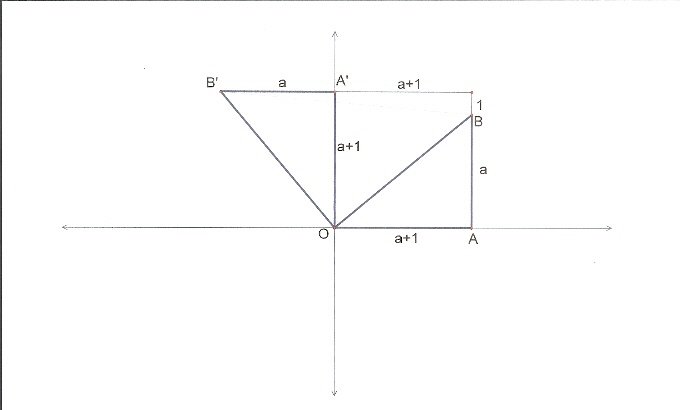- About MAA
- Membership
- MAA Publications
- Periodicals
- Blogs
- MAA Book Series
- MAA Press (an imprint of the AMS)
- MAA Notes
- MAA Reviews
- Mathematical Communication
- Information for Libraries
- Author Resources
- Advertise with MAA
- Meetings
- Competitions
- Programs
- Communities
- MAA Sections
- SIGMAA
- MAA Connect
- Students
- MAA Awards
- Awards Booklets
- Writing Awards
- Teaching Awards
- Service Awards
- Research Awards
- Lecture Awards
- Putnam Competition Individual and Team Winners
- D. E. Shaw Group AMC 8 Awards & Certificates
- Maryam Mirzakhani AMC 10 A Awards & Certificates
- Two Sigma AMC 10 B Awards & Certificates
- Jane Street AMC 12 A Awards & Certificates
- Akamai AMC 12 B Awards & Certificates
- High School Teachers
- News
You are here
Dear Professor Greitzer - Practically Isosceles Triangles
In Figure 6 we show how to rotate a practically isosceles right triangle and create a larger REALLY isosceles right triangle.

Figure 6
Practically isosceles right triangle OAB, whose legs are a and a+1, rotated 90o around O, creates OA’B’. Triangle OBB’ is a right isosceles triangle, because we rotated 90 degrees and OB=OB’. Since angle OB’A’ was just slightly over 45o (note that side OA’ is the longer leg), and angle OB’B is exactly 45o, angle A’B’B must be the little adjuster, the amount we subtract from OB’A’ to make the slightly over 45o into the exactly 45o OB’B. What’s very neat is that the slope of segment B’B is easy to read. To go from B’ to B, you drop 1 (because the legs were consecutive integers), and you run an amount equal to the sum of the legs.
We now know the adjuster angles for each of the practically isosceles triangles listed on page 4.
From the 3-4-5 triangle we get 45o = arctan(4/3) - arctan(1/(4+3)) or
$${\frac{\pi}{4}}=\arctan{\frac{4}{3}}-\arctan{\frac{1}{7}},$$
and from the observations that produced Chart 2, where we bisected angles, we know that arctan(4/3) = 2arctan(1/2), so we may write
$${\frac{\pi}{4}}=2\arctan{\frac{1}{2}}-\arctan{\frac{1}{7}}.$$
This starts to look like (!!!). From the 20-21-29 triangle, we get 45o = arctan(21/20) - arctan(1/(21+20)) or
$${\frac{\pi}{4}}=\arctan{\frac{21}{20}}-\arctan{\frac{1}{41}},$$
and, from Chart 2, we know that arctan(21/20) = 2 arctan(3/7), so we may write
$${\frac{\pi}{4}}=2\arctan{\frac{3}{7}}-\arctan{\frac{1}{41}}.$$
From the 119-120-169 triangle, we get 45o = arctan(120/119) - arctan(1/(120+119)) or
$${\frac{\pi}{4}}=\arctan{\frac{120}{119}}-\arctan{\frac{1}{239}},$$
and we look to Chart 2 to find the slope that goes with an angle half as large as that whose associated slope is 120/119.
It’s not there; we didn’t build the chart that large. But we know how to find it, and we are encouraged that the result will be rational, because 119-120-169 is a Pythagorean triple. So we add an additional row to the chart, which you can read in Chart 3.

Aha! We already bisected the angle associated with a 5/12 slope in that same chart, and its terminal side has slope 1/5. So arctan(120/119) = 2arctan(5/12), and arctan(5/12) = 2arctan(1/5). Therefore we have arctan(120/119) = 4arctan(1/5) and, since 45o = arctan(120/119) - arctan(1/239), we have our result:
$${\frac{\pi}{4}}=4\arctan{\frac{1}{5}}-\arctan{\frac{1}{239}} \quad {\rm !!!}$$
Did our classes walk the entire road? Truthfully, no ... but they walked a good deal of it and there’s nothing they couldn’t have walked; it’s just elementary geometry that gradually became couched in higher mathematics vocabulary. How did Machin find his (!!!)? We don’t know, but in the spirit of exploration, this road gets there pretty quickly, with fruitful side roads, and needs no “higher mathematics”. Professor Greitzer, we enjoyed reading your articles for many years. We hope you get the opportunity to enjoy reading this one.
P.S. The Arbelos article also contained this formula:
$${\frac{\pi}{4}}=4\arctan{\frac{1}{5}}-\arctan{\frac{1}{70}}+\arctan{\frac{1}{99}}\quad {\rm !!}$$
The interested reader will find all of the necessary tools to “discover” this formula in the present article.
Joe Richards and Don Crossfield, "Dear Professor Greitzer - Practically Isosceles Triangles," Convergence (July 2010)




